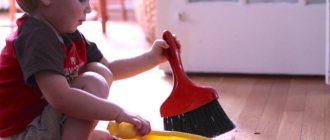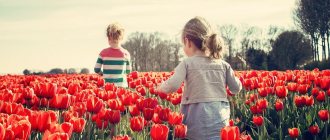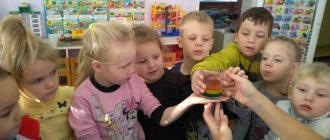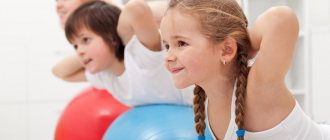Means and methods of aesthetic education of children in kindergarten
Korotkova Svetlana
Means and methods of aesthetic education of children in kindergarten
Means and methods of aesthetic education of children in kindergarten.
The basis of the process of aesthetic education is the joint activity of the teacher and the child, aimed at developing his abilities to perceive beauty , artistic values and productive activity. General issues of aesthetic education of children include : an organized environment in which a child grows up and is brought up , the use of works of art (reproductions of paintings, prints, sculptures, etc.) in the design of the premises of a preschool institution, involving children in artistic activities, taking into account the interests and inclinations of children .
The means of aesthetic education of children objects and phenomena of the surrounding reality selected by the teacher and specially organized for the upbringing of children
1. Aesthetics of everyday life.
It is designed to teach a child to feel and understand the beauty of life, to cultivate in him the desire to create and preserve it. The artistic design of a preschool institution is determined by the content of educational work , the requirements for protecting life and promoting health, and its artistic development. Cleanliness and order are not only hygienic, but also aesthetic requirements for the interior of a kindergarten . It is important that the design be stylistically consistent. by children , parents, and teachers to decorate the premises . the kindergarten playground must also meet the appropriate hygienic and aesthetic .
2. Works of art.
They are used in the design of everyday life, during training, and independent activities. For this purpose, works of everyday and fairy-tale painting are selected (portraits, still lifes, landscapes, graphics (prints, engravings, book illustrations, small forms of sculpture (products made of earthenware, plaster, wood, works of decorative and applied art (ceramics, art glass, folk decorative and etc.)
.
Various activities in kindergarten are necessarily accompanied by music (morning exercises, leisure activities, etc.)
.
3. Nature.
Growing up among nature , a child learns to see the harmony, beauty, richness of colors of each season, to reproduce his impressions in oral stories, drawings, etc. All this is accompanied by the teacher’s stories that nature is a powerful and perfect creator of beauty, painters draw inspiration from it , composers, writers, the use of their works (for example, “Seasons”
P. Tchaikovsky, reproductions of paintings by I. Shishkin, etc.).
Excursions to nature are effective, because the impressions a child experiences in preschool leave an imprint for life. It is important for the teacher to choose words to accompany observation that would meet the objectives of aesthetic education .
4. Special training.
The formation of ideas about beauty, skills in artistic and creative activity, the development of aesthetic assessments , experiences and tastes is facilitated by special training for preschoolers in kindergarten . To do this, they use various types of activities, artistic and didactic games, holidays, matinees, excursions, walks, watching movies and TV shows, performances, etc.
5. Independent artistic activity of children .
It is an important means of aesthetic education for preschool children . In the process of artistic activity, they realize their creative ideas, inclinations, which can subsequently develop into the ability for artistic creativity.
The development of independent artistic activity is stimulated by the following factors:
— the learning process in the classroom, its developmental nature, the formation of methods of independent action;
- artistic impressions of children , encouraging them to further implement them in activities;
- pedagogically appropriate aesthetic subject environment ;
- the encouraging influence of parents who stimulate the creative searches and attempts of children ;
- indirect influence of the teacher who initiates the independent search of children .
To develop independent artistic activity in the group, special zones (centers)
with the necessary equipment and materials that children can freely use.
At the same time, the teacher takes care of the variety of children’s , the combination of various types of artistic activities: visual, artistic and speech, theatrical and playful, musical.
6. Holidays.
They are associated with children's vivid aesthetic experiences and the desire to test themselves in different genres of art. Preparation for the holiday, the participation of children in the creation of its program, the conditions for holding it, and the anticipation of the festive action form a special pre-holiday collective mood. of children are often involved in the preparation and celebration , which gives them emotional warmth.
Interesting plans of a teacher for organizing the aesthetic education of preschoolers can achieve their goals by correctly selecting and combining his methods , which are classified according to various criteria:
- according to the main pedagogical goal.
These methods include : persuasion; exercises in practical actions aimed at transforming the environment ; problematic situations that encourage creative and practical action; incentives for empathy, an emotionally positive response to the beautiful, a negative attitude towards the ugly;
- in general and special areas.
This group includes general pedagogical and special methods , the selection of which depends on the type of art that the teacher seeks to introduce children ;
— methods of teaching artistic activity.
Among them are visual (sample, demonstration of techniques for performing actions, verbal (conversations, instructions, instructions, advice, assessment and self-assessment of the results of children’s );
— methods children’s artistic and creative abilities .
They are based on developing in children the ability to act when solving problem-search tasks in non-standard situations.
Researchers suggest using game-based teaching techniques, game situations, and acting out children’s works in the classroom the aesthetic education , which creates a positive emotional atmosphere, promotes effective mastery of fine arts and abilities, improves the quality of work and promotes the development of interest in fine arts. It is especially important to ensure a combination of various types of activities in the development of artistic skills of preschoolers.
Since in preschool age a child is primarily inclined to play, it is necessary to widely use a variety of gaming techniques in order to develop his creativity:
- game situations that help develop cognitive and creative activity;
- songs, riddles, poems, fairy tales, musical works;
- demonstration of episodes of puppet performances that focus attention , evoke positive emotions, interest in what is being depicted, deepen aesthetic pleasure , but do not affect the results of the work;
- stories - drawing with fairy tale elements; search situations; imaginary situations.
Children who have identified certain skills and interests in artistic and visual activities form a contingent of preschool institutions of artistic and aesthetic direction , in which, under the guidance of teachers with an artistic education, clubs, studios, and creative workshops function. Children are invited to participate in them , according to their inclinations and interests. Artistic activity creates serious opportunities for the manifestation of a child’s individuality, therefore, his knowledge and the development of artistic abilities are the primary condition for the child to understand himself as a person endowed with creative potential, to cultivate responsibility for his talent, as a gift from God, to strive, overcoming tough tests, to uniquely realize his talent. The history of world culture knows many examples when a child began to realize all this at an early age. Therefore, every teacher should proceed from the fact that, perhaps, his students harbor such dreams.
Aesthetic development is associated with the formation of all facets of personality. In preschool age, the foundations of needs and tastes are formed, a love of art is born, and creative abilities, which every child is endowed with to varying degrees, manifest themselves. To implement them, it is necessary to have properly organized education and training , which takes into account the characteristics of the age and individuality of the child.
Art
An important means of aesthetic education is, of course, art. Works of art make a person see life through images. Aesthetic pleasure when contemplating works of art arises as a result of the experience of participation in the creativity of artists. Art allows us to bring artistic expression into everyday life.
Art fills schoolchildren’s free time, fills it with socially valuable content, satisfies the interests and needs of the individual, and makes development diversified. Art can relieve tension and stress from study, work, and sports. Art captivates and transports a person into the world of new emotional states that switch mental activity and create relaxation.
Raising a child through activity is a natural feature of upbringing. Artistic activities include various theatrical games or performances, verbal and artistic creativity, music playing, visual and arts and crafts, and design work. All of the listed means of aesthetic education are effective both on their own and in conjunction.
Literature is the art of literary expression. Literature helps to reproduce images of works of art in your imagination, characterize heroes and analyze their actions. As a result of mastering the culture of reading, students begin to think about what the book teaches and experience deep and vivid impressions.
Music as a means of aesthetic education teaches us to perceive musical works and ensures the acquisition of simple performance skills. Music gives rise to lyrical feelings in a person, develops an ear for music, harmony, artistic taste, and has an impact on various areas of the personality.
Visual arts introduces works of art; elements of art history that contribute to the formation of skills in practical depiction, visual literacy and creative self-expression.
Aesthetics of everyday life
It is important to awaken in students the desire to affirm beauty wherever they spend their time, do business or relax, to involve them in creating an aesthetic environment around them. Only after this is it possible to use various means of aesthetic education. The environment in which a child lives and develops plays an important role in the development of aesthetic feelings. If the environment is aesthetic, beautiful, if there are beautiful relationships between people, the speech that the child hears is correct and pure, then he will accept the aesthetic environment as the norm and strive for it. Therefore, it is important to pay attention to the aesthetics of everyday life. The aesthetics of everyday life also includes a person’s appearance. The aesthetics of everyday life is the background that reinforces or destroys emerging ideas about beauty.
A game
An important means of aesthetic education is play. Play activity creates a special emotional field in which the child, naturally, without coercion or edification, of his own free will strives for self-expression, self-knowledge, and independence. Today, games that contribute to the development of the aesthetic orientation of a child’s personality and the identification of the actual level of learning are very popular. The range of games used for the purpose of aesthetic education is large (Fig. 2).
Fig.2








